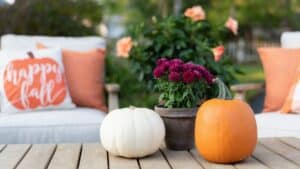
October Gardening Tips for North Florida
Enjoy our October gardening tips resource specifically for Jacksonville and area beaches communities.
What To Plant and What To Do
Annuals (Or Grown As Annuals): Chrysanthemum season is here! See our handout on Chrysanthemums for tips on how to keep them flowering longer and prettier. CLICK HERE! Other great options are diascia, lobelia, marigolds (Tagetes), million bells (Calibrachoa), nemesia, ornamental pepper (Capsicum), verbena, and wax begonia. As temperatures cool, alyssum (Lobularia), dianthus, ornamental cabbage/kale (Brassica), snapdragons (Antirrhinum), and Supertunias (Petunia) are also favorites for this time of year. Toward the end of the month you can include viola and pansy (Viola). If temperatures remain high, you may also be able to continue to grow heat-loving plants like coleus (Plectranthus), pentas, purslane (Portulaca) and zinnias a little longer.

Perennials: Usually flowering this time of year are asters, baby sunrose (Aptenia), black-eyed Susan (Rudbeckia), cigar plant (Cuphea ignea), coneflower (Echinacea), coreopsis, dune sunflower (Helianthus), firecracker plant (Russelia), goldenrod (Solidago), Joe Pye weed (Eupatorium), lantana, Mexican bush sage (Salvia leucantha), ornamental grasses, plumbago, Russian sage (Perovskia), salvias, and shasta daisy (Leucanthemum). Some of these plants may support birds and butterflies which are still migrating through. African and Regina irises, agapanthus, baptisia, flax lily (Dianella), foxglove (Digitalis), foxtail fern (Asparagus), Mexican heather (Cuphea hyssopifolia) and purple queen (Tradescantia) are also noteworthy additions to the fall garden. But as noted above, most perennials that grow here could be planted this time of year. Exceptions would be winter tender plants that would be best planted in late spring once the ground warms up, giving them all summer long to become established before winter. Indoors plant Amaryllis bulbs, which take about 5-10 weeks to bloom, for holiday flowers. See our handout on growing Amaryllis CLICK HERE!.

Groundcovers: You can install groundcovers and border plants like ajuga, Asiatic jasmine (Trachelospermum), autumn fern (Dryopteris), Aztec grass (Liriopogon), blue-eyed grass (Sisyrinchium), blueberry flax (Dianella), creeping fig (Ficus), foxtail fern (Asparagus), holly fern (Cyrtomium), lily turf (Liriope), mondo grass (Ophiopogon), perennial peanut (Arachis) and society garlic (Tulbaghia).

Succulents: Succulents are always useful. Cold hardy succulents can be planted outdoors and tender succulents make great indoor plants where bright light is available.
CLICK HERE FOR CARE GUIDES!
Vines: Vines which can be planted this month include Carolina jessamine (Gelsemium), confederate jasmine (Trachelospermum), coral honeysuckle (Lonicera), crossvine (Bignonia), English ivy (Hedera), morning glory (Ipomoea), native wisteria (Wisteria frutescens), passion vine (Passiflora), railroad vine (Ipomoea) and yellow butterfly vine (Mascagnia).
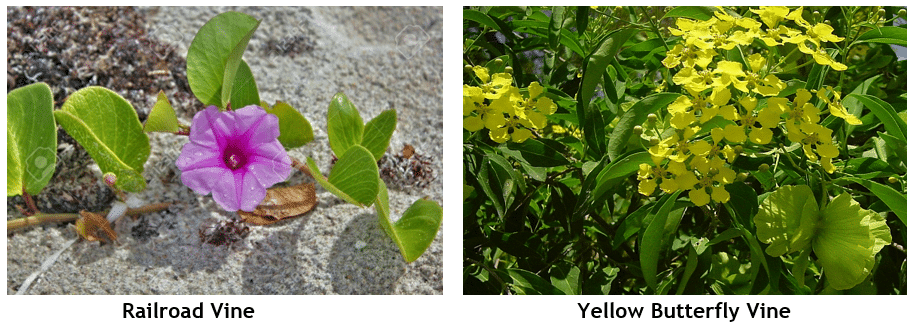
Shrubs and Trees: When temperatures start to cool off, it is also a great time to plant most shrubs and trees. If the fall and winter is dry, be sure to especially water evergreen types since they are more prone to desiccation. Plant trees which are blooming at this time, such as Crape myrtle (Lagerstroemia), so you can get a first-hand look at the flower. Sasanqua camellias should be starting to bloom. The native beautyberry (Callicarpa) is stunning this time of year with its bright purple berries. Planting hollies can provide attractive holiday berries which are also appreciated by wildlife. Remember to ‘Dial Before You Dig’ (811) if the hole is deeper than your shovel blade.
Palms: Palms which should be sufficiently hardy to plant in fall are cabbage (Sabal), European Fan (Chamaerops), needle (Rhapidophyllum), pindo (Butia), silver saw palmetto (Serenoa), Sylvester (Phoenix), Washington (Washingtonia), Windmill (Trachycarpus) and the cycad coontie (Zamia).
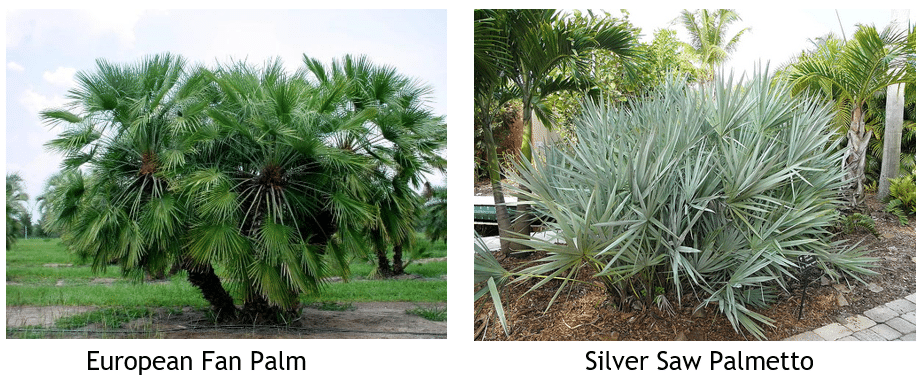
Vegetables and Herbs: Continue to start seeds of cool season vegetables such as radish, lettuce, mustard greens, spinach, kale, arugula, beets, brussels sprouts, kohlrabi, Mexican tarragon, celery, cabbage, Chinese cabbage, Swiss chard, endive, carrots, cauliflower, broccoli, collards, and turnips. See our handout Starting Plants from Seeds Indoors CLICK HERE!. Some crops with roots may be difficult to transplant so should either be direct sown into the garden or started in decomposable pots. Others like broccoli, cauliflower, brussels sprouts and lettuce are more reliable and easier to space as transplants. Begin planting transplants once the summer heat breaks. It’s time to plant onion sets and garlic bulbs. Since they are grown as an annual crop here, strawberries can be planted September through November. Some of these vegetables, like spinach, carrots, kale and Swiss chard, can survive in your garden all winter. See our handout Planting Guide for North Florida Vegetables for vegetable growing information CLICK HERE!
You may still be able to plant tomatoes at this time if done early in the month. Plant them deeply; only about 4 inches of the top of the plant needs to extend above the soil. This is the only vegetable you can plant this way, but it allows the stem to produce more roots to feed the plant. Very tall transplants can be laid on their side in a trench with just the top above ground. Leave a small depression around the plant for a water reservoir. See our handout What Matters with ‘Maters to help you decide which tomatoes to grow CLICK HERE!.
These herbs can be started as seeds now, or planted as transplants: chives, oregano, rosemary, salad burnet, sage, thyme, winter savory, lemon balm, lovage, ‘Phenomenal’ lavender, Spanish lavender, and mint. Dill and parsley can be started this month from seed, and bay laurel, African blue basil, basil, fennel and sorrel can be planted as transplants. Some of these herbs will grow through winter. Of the more commonly grown herbs, parsley, chives, cilantro (too early to start this month), dill, fennel, some mints, oregano, rosemary, garden sage and thyme can survive freezing temperatures. Less hardy into fall and winter are basil and stevia, and the cilantro and Cuban oregano you finished planting last month. Some of the herbs like dill, fennel and lavender may attract beneficial insects. See our handouts Planting Guide for North Florida Culinary Herbs CLICK HERE! and Herbs for North Florida CLICK HERE!, for more growing and use information.

What to Do
What to Do for Specific Plants
Avocados – If not done last month, you may want to apply a final fertilization of your avocado tree for the season. Fertilizer requirements change with the age and fruiting status of the tree. The amount of fertilizer should be proportionate to the size of the tree, not to exceed 20 lbs per tree per year. Use a fertilizer with a 6-6-6 to a 10-10-10 ratio with added 4-6% magnesium for young trees. Increase the potassium (third number) to 9-15% and reduce phosphorous (second number) to 2-4% for bearing trees.
Azaleas – Although the nutritional requirements of azaleas are low compared to most shrubs, they can benefit from frequent light applications of an acid-forming fertilizer containing iron and other micronutrients, in sandy soils. Apply a final slow release acid fertilizer this month, in a ratio similar to 2-1-1.
Bamboo – Bamboos should receive 3-4 applications yearly of a slow release high-nitrogen fertilizer with the winter application being light. If you haven’t fertilized for a few months, then you should do so now.
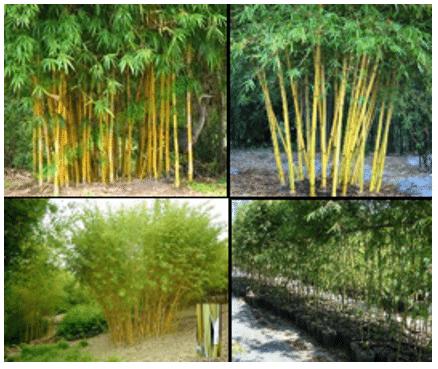
Bananas – Feed ½ to 1 lb. dry fertilizer in a ratio of 3-1-6 plus magnesium every 1-2 months for plants under 6 months, 1 to 2 lb. for 6-12 month-old plants, 2-3 lb. for plants 12 to 18 months old and 3-4 lb. for those plants over 18 months. This should be done during the growing season in zone 9 (or throughout the year in warmer areas). One to two foliar applications of a nutrient spray containing magnesium, manganese and zinc should be applied between April and October so if not done in September, it could be done this month. Also, iron should be applied to the soil once or twice between April and October. Monitor banana stalks for weevil infestation and the leaves for sigatoka, a fungal leaf-spot disease. Prune out developing suckers to maintain 3-4 stalks of different ages – one that may be left to flower and fruit, another about half the size and 1-2 more suckers. The trick to getting fruit is to protect the pseudostem from freezing this fall and winter so you start with a well developed pseudostem in early spring. Look for directions next month on how to overwinter your banana plant.
Blueberry – Maintain several inches of acid-forming mulch such as pine bark, pine straw, or oak leaves. This can be the final month of the season for a light application of acid fertilizer, spread evenly over a circle 2′ in diameter with the plant in the center. The circle can be larger as the plant grows, using 1, 2 and 3 ounces of 12-4-8 plus 2% Mg. Use ammoniacal nitrogen or nitrogen from urea or organic sources, rather than from nitrate sources, and low chlorine levels. A “blueberry special” or “camellia-azalea” fertilizer should be suitable. More fertilizer may be needed if plants are heavily mulched.
Camellias – Newly planted camellias don’t need fertilizer.
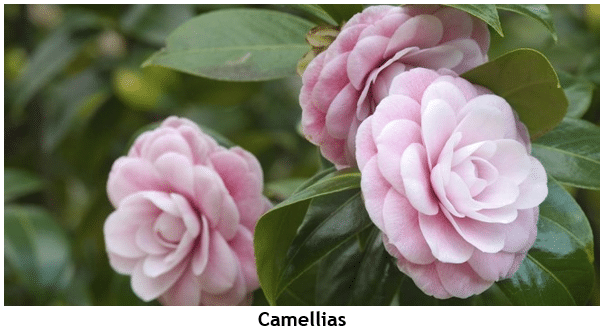
Cane berries – Blackberries: The need for irrigation will decline by fall but is especially important in the first year. Weed control is also very important. Raspberries: Watch for powdery mildew and remove and destroy infected plant parts; spray remaining plant material with a fungicide.
Citrus – Fertilize citrus with a balanced fertilizer (for example an 8-8-8 analysis) in early October if not done last month, for a final feeding during the growing season. If the weather has been rainy, do not use soluble nitrogen as rains will leach it from the soil too quickly. If you are growing your citrus in a container it should be moved indoors before a freeze. See our handout Citrus Care Guide for more information. CLICK HERE!
Drift Roses – Prune a final time for the season in late summer/early fall to remove older looking foliage and encourage a new flush of foliage and flowers for fall. Drift roses can be fertilized at the same time. For more details, see our handout Drift Rose Care. CLICK HERE!
Fig – If fig rust is active, control with a Bordeaux spray (5-5-50 ratio of copper sulfate, lime and water) applied every 2-3 weeks.
Gardenia – Gardenias bloom on both new and old wood, with different varieties blooming predominantly differently on one versus the other. Any light pruning should have taken place by now. If you have an old gardenia that is overgrown or become spindly, it should be renovated in 3 steps. Pruning should begin in early fall but should be light (removing about one fourth of the foliage) so it’s less likely to suffer cold damage. Plan to prune again next year in early March and a third time after blooming, around mid-summer. Follow calendar instructions for those months next year. Scout for mealy bugs, aphids, scales and whiteflies. Insecticidal soaps or horticultural oils can help.
Ginger– If nights become cool enough this month for the foliage to die back, dig up the roots, which will have multiplied. Harvest some and plant some back into the ground for next year’s crop.
Hibiscus – Scout your hibiscus regularly for pests such as aphids, whiteflies and mealybugs. If caught early they are easily controlled with insecticidal soaps or horticulture oils. You should never use the pesticide malathion on hibiscus.
Hydrangea – Flower buds are forming now on oakleaf hydrangeas (Hydrangea quercifolia), and on mophead and lacecap hydrangeas (H. macrophylla), including reblooming varieties that also flower on new wood. Pruning is inadvisable; also resist simple deadheading or cutting late blooms for arrangements, unless cutting above the first set of large leaves.
Late summer and fall may bring a leaf spot disease which appears as small brown or purple spots on leaves. It does not usually threaten plant health and can be controlled by removing dead and diseased leaves and avoiding overhead irrigation. Powdery mildew can also occur in fall, also not usually threatening plant health. The best way to prevent this is by using resistant varieties of hydrangea.
Knockout Roses – Prune a final time for the season in late summer/early fall to remove older looking foliage and encourage a new flush of foliage and flowers for fall. Knockout roses can be fertilized at the same time. For more details, see our handout Knockout Rose Care. CLICK HERE!
Landscape beds – Although organic matter can be added any time of year to improve the quality of the soil and provide a nutrient reserve, many gardeners add 1-3″ in fall so that by spring, soil organisms will have worked the compost into the soil. Move your mulch out of the way and after adding organic matter, replace deteriorating mulch with a new 2-3″ layer. This will moderate soil temperatures, retain soil moisture, reduce erosion and weeds and add additional organic matter as it decomposes. Mulch also creates an attractive unified look to highlight your plantings. Florida’s warm and often wet weather can lead to rapid breakdown of mulch. We can help you determine how much mulch you need for a specific area.
Continue to fertilize annuals to extend the bloom season into fall but take care not to over-fertilize.
Continue to monitor disease in landscape beds. Fungal disease can occur almost any time of year, especially if the landscape is over watered or watered at the wrong time of day. Watch for powdery mildew late in the growing season. Remove all the infected plant parts and destroy, do not compost, them. Follow with a spray of fungicide. Effective organic fungicides for treating powdery mildew include sulfur, lime-sulfur, neem oil, and potassium bicarbonate.
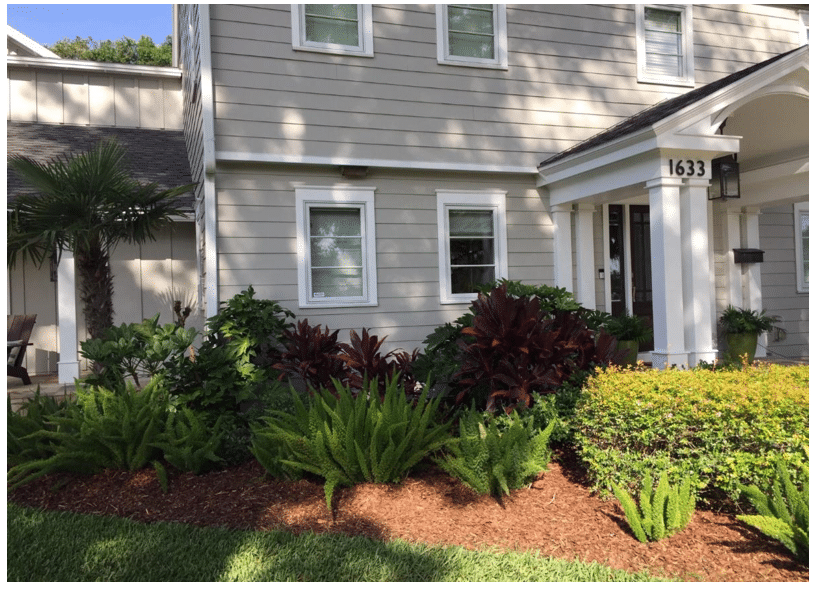
Also continue to frequently scout landscape and garden beds (indoor plants too!) for insects such as scale, whiteflies, aphids, mealy bugs and leaf beetles as they are easier to control when first noticed. Pest pressure may be high for fall crops. Aphids can sometimes be controlled with sprays of water or by picking them up with a vacuum or sticky tape. Insecticidal soaps can also be used but these will harm Monarch butterflies and their young, so typically aren’t used on Butterfly Weed/Asclepias. Spinosad is particularly effective on thrips and caterpillars (also leafminers, spider mites, mosquitoes, ants and fruit flies) and lasts up to 4 weeks. Additionally, it is safe for people, beneficial insects and adult butterflies, and safe for bees once it has dried.
Spray spider mites with good coverage of a horticultural oil or use insecticidal soap in several applications. Neem oil is a good combination product that can be used to combat insects, mites and fungus.
Beneficial insects such as ladybug beetles and lacewing can control soft-bodied insect pests. To maximize the effectiveness of these natural enemies, provide habitat and relief from high temperatures by increasing the amount and diversity of plants in your landscape. Refer to our handout Ladybugs, for storage and release information. CLICK HERE!
Lawns – Continue to mow but less frequently when the weather begins to cool and days get shorter. Never remove more than 1/3 of the leaf blade at a time and mow to the highest recommended height to support root growth. Here are the recommended mowing heights for several N. Florida grasses: Bahia grass at 3-4 “, Zoysiagrass coarse textured varieties at 2 to 2½” and fine textured at 1″, Centipedegrass at 1½ to 2½”, Seashore Paspalum at 1½ to 2″, and St. Augustinegrass at 2½” for dwarf and semi-dwarf cultivars such as Delmar, Seville and Captiva, and 3.5 to 4″ for standard St. Augustinegrass, especially if growing in shade. To maintain at a height of 4″, grass should be mowed before it grows to a height above 6″. Sharpen mower blades frequently, even monthly, to avoid damage to the grass which could allow disease to enter. Avoid mowing when grass is wet.
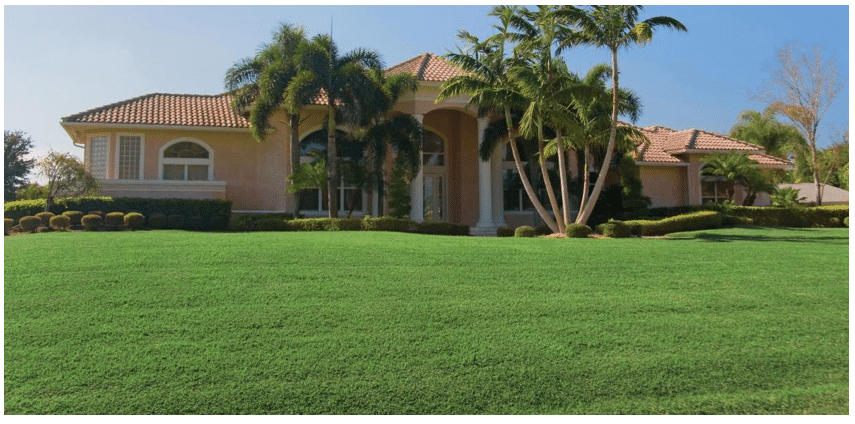
Applying lime, when needed, can be done in the fall but a soil test should be done first. Lime is often not needed here and raising the soil pH can impair performance, and even kill grass if it is too high.
Fungal disease in lawns continues to be a problem in early fall as in summer, when Florida receives the majority of its rain. Susceptible lawns may see the return of Large Patch if it wasn’t controlled in spring. Take-all Root Rot is also prevalent this time of year, can occur in any warm-season turfgrass and is intensified by any type of stress. Initially, yellowish foliage eventually turns brown and wilts. As the turf thins, brown, irregular patches develop from 1 to more than 20′ in diameter. The roots of infected grass are usually blackened and rotted. You can tell the difference between Take-all and Large Patch disease by the stems. Grass blades with Large Patch have rotten stems which can be slipped easily from the base of the plant.
The best action against fungal diseases is proper lawn care. Avoid over-watering and over-fertilizing. Adjusting the soil pH to neutral or slightly acidic levels may reduce Take-all Root Rot over time. Fungicides such as Bonide Infuse Systemic Disease Control can be useful to control Take-all Root Rot and other fungal diseases once they show in your lawn, but preventive applications need to begin about June for Take-all root rot and early spring for Large Patch, before symptoms appear. If your lawn has experienced these diseases, you can plan for prevention next year.
For the best weed prevention and control in lawns, follow mowing, irrigation and fertilization recommendations. Hand-pull weeds that are setting seed, to ensure seed removal. Post-emergent herbicides are less effective if the weed is mature, producing seed, under drought stress, or if mowed within several days of herbicide application. But if herbicides are required, Fertilome Weed Free Zone is a post-emergent herbicide for broad leaf weeds useful in 45-90°F temperatures. It shouldn’t however be used on the Floratam variety of St. Augustinegrass. Fertilome Selective is useful for spot treatment in temperatures between 50-85°. To control nut-sedge and dollar weed, make sure you’re not creating favorable conditions by over-watering your lawn. Best herbicidal control of these are with young, growing weeds. Always choose an herbicide that lists your lawn type on the label and follow instructions carefully as they can vary.
Potential problem lawn insects in October continue to be Southern chinch bug, fall armyworms, mole crickets and tropical sod webworm.
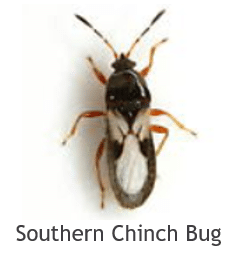
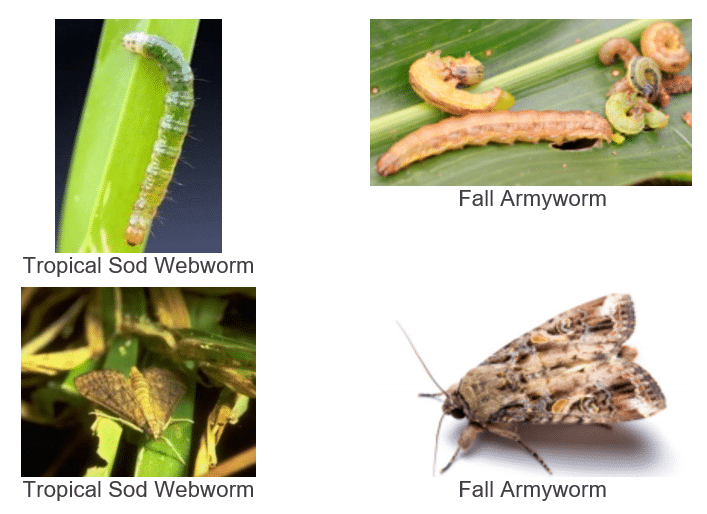
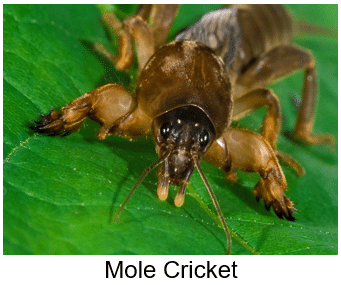
Chinch bugs prefer hot, dry conditions. They suck the juices from St. Augustinegrass at or just below the soil level. Yellowish to burnt-brownish patches are often first noticed in sunny areas along sidewalks and driveways, or in poorly irrigated areas. To help control the problem, limit nitrogen fertilizer and reduce thatch thickness to minimize the bug’s habitat.
Newly hatched larvae of tropical sod webworm skeletonize grass blades while older larvae chew on grass blades near soil surface. Small patches of grass may look ragged and irregular. The adult moth does not cause damage but the life cycle from egg to adult only requires 5-6 weeks at 78°F.
Fall armyworm caterpillars skeletonize grass blades then later create bare spots.
Younger caterpillars of both armyworm and webworm are more easily controlled with reduced-risk products like B.t., halofenozide and spinosad. Bifenthrin also targets both these caterpillars and chinch bugs. Rotate combination products to reduce resistant populations and spot treat when possible.
Adult mole crickets are about 1 1/2 inches long, light brown, and have enlarged forelegs that they use to dig in soil. They feed at night during warm weather, after rain or irrigation. They also fly for 1-2 hours at dusk so outdoor lighting may attract them to your yard. Mole crickets cause damage by tunneling (dislodging and drying out plants), and by feeding on grass roots and blades. Small mounds of pushed up soil, reduced turf density and patches of bare soil may be seen. A number of cultural, biological and chemical controls are useful in combination against mole crickets, but chemical treatments are best done by mid-June when they are small.
In weedy areas and open fields, Lubber Grasshopper adults may be found from March to November. It may be possible to avoid the use of an insecticide by hand-picking the grasshoppers and mowing vegetation to appropriate heights.
Proper lawn care involves many tasks. A landscape maintenance program is a convenient way to keep up with the needs of your lawn.
Palms – Fertilize palms about every other month during the growing season, so if you didn’t fertilize last month then do so this month. Palms need a high potassium to nitrogen ratio plus added magnesium so an 8-2-12 fertilizer with 4% magnesium works well. Prune out only dead leaves (when they occur).
Pomegranate – For a one-year-old tree, apply 1/3 to 2/3 cup of a balanced 10-10-10 formula fertilizer this month, if not done in September. Scratch it lightly into the soil at the tree’s root zone, in a circle 1 or 2 feet in diameter, or larger if the tree is older. If the tree is in its second year, use about twice as much fertilizer, and about 3 times as much in the third year and beyond.
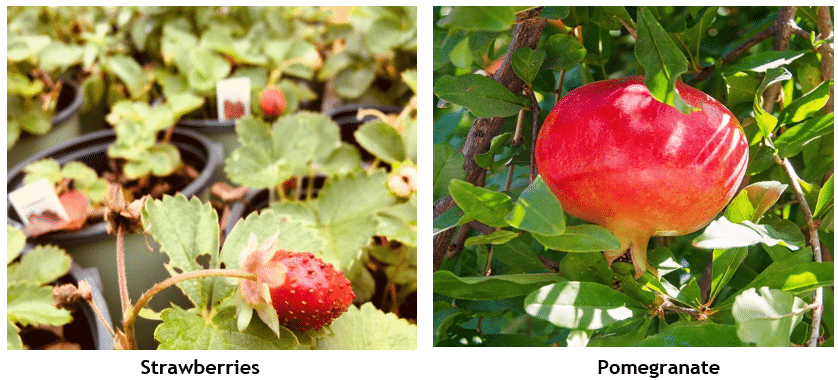
Strawberries – Strawberries are best planted in September through November in north Florida and grown as an annual because of our summer heat. Outside of Florida, most strawberry plants are grown over several years (perennial) so appropriate guidelines to grow them here are difficult to find in the general information base. Plant in mounds or otherwise well-draining soil that is also high in organic matter. Without a soil sample, mix 1-2 pounds per 100 square feet of a balanced ratio of nitrogen, phosphorus, and potassium 6″ into the soil before planting. At least one-half of the nitrogen in the fertilizer should be in a slow release form. If you prefer growing organic strawberries, blood meal can be used to increase nitrogen, bone meal can be used to increase phosphates and a wood ash mulch can be added for potassium. Mulch with pine straw needles to increase soil acidity and keep fruit clean. Too much N causes malformed fruit, excessive vegetative growth and fewer fruits. Excess K leads to smaller and fewer fruits. Boron is a micronutrient that may be deficient in your soil for strawberries.
Remove runners as you notice them start to develop. This will direct more energy to berry production.
Fungal problems may start with wet weather. Most diseases on leaves, flowers, or fruits can be controlled with fungicides for home garden use; make sure the label specifies it can be used on strawberries. Sulfur can control powdery mildew but make sure temperatures are cooler than 80°F before applying sulfur to avoid burning fruit and foliage. Watch for aphids and thrips.
Turmeric – Harvest bright yellow underground rhizomes in fall when the plant goes dormant.
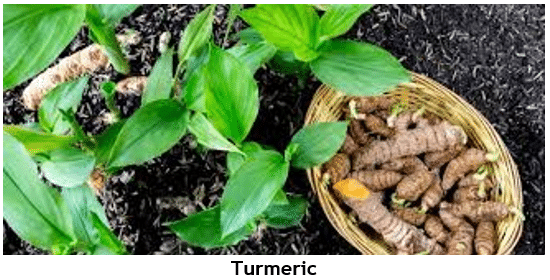
What to Do in General:
Start a fall garden – If you haven’t already, now is the time to start your fall vegetable garden. You can refer to our handouts Start a Fall Vegetable Garden CLICK HERE! and Starting Plants from Seeds Indoors CLICK HERE! to get you started. If you’ve had previous crops, you should consider some crop rotation to avoid building pests in your garden. See our handout Planting Guide for North Florida Vegetables CLICK HERE! for family designation of crops so you can avoid planting successive families. The What to Plant section of this calendar lists the appropriate crops to start this month.
Clean out the summer crops that are spent and remove any other debris. Don’t compost anything that looks diseased as the heat may not kill certain diseases and nematodes. Reinforce raised bed structures if needed or clean up the boundaries of your beds. A soil test would be advisable at this point; you can use the Duval County Extension Service (http://soilslab.ifas.ufl.edu/ESTL%20Home.asp). Based on test results, add recommended amounts of fertilizer. Next add organic matter. Compost improves soil and plant growth regardless of the type of soil you’re adding it to. Spread a 3-4 inch layer over the bed and lightly work in. Refer to our handout Start a Fall Vegetable Garden CLICK HERE! to complete planting.
Feed vegetables a slow/continuous release organic fertilizer applied every 3 to 4 weeks (herbs at half strength). In general, even though it’s a little costlier, try to use a slow release fertilizer or fertilizer with at least 30% as a slow release component. These feed plants more consistently and lessen pollution.
Irrigate – Complete watering restrictions and schedules for Duval County can be found at this link: www.sjrwmd.com/wateringrestrictions. Irrigation systems should be checked at least monthly for breaks or misaligned spray heads. Although the frequency you water turf will change seasonally, the amount should always be ½ to ¾” of water per watering. For most Florida soils this delivers the most water to plants without causing runoff. To determine how long it takes to deliver the correct amount of water to your landscape, you can use the ‘can method’ suggested by the U. FL (http://gardeningsolutions.ifas.ufl.edu/care/irrigation/calibrating-your-irrigation-system.html). Also keep in mind that your irrigation system should be set to accommodate plantings differently than for turf. If you’ve watered your winter tender plants correctly over the summer, they will more likely come through a hard winter unscathed. Rockaway, Inc.’s Maintenance Service Division can evaluate the operation and delivery of your irrigation system for turf and plantings.

Prepare for possible hurricanes – Prune any dead limbs and open up trees to allow for better airflow. Install lightning protection on tall high value trees. Have a plan to remove and store, or tie down, garden art, pots, hanging baskets, bird feeders, grills and other yard structures. If a hurricane is imminent, remove debris from storm drains to ensure a clear path for storm water. Clean out gutters and downspouts. Remove coconuts and large palm seeds that could release in the storm and cause serious damage. Turn automatic sprinkler systems off. Do not empty your pool; protect your pump and pool equipment.
When planning your landscape, avoid planting fast growing trees that have brittle wood. Wind resistant trees for North Florida include Live Oak, Sand Live Oak, Dogwood, Dahoon Holly, Yaupon Holly, Inkberry, American Holly, Crape Myrtle, Southern Magnolia, Podocarpus and Cabbage Palm. Most palms in general, except Queen Palm and Washington Palm, are more resistant than broad-leaved and conifer trees.
Harvest – These should be fruiting now: Fig trees, pecans, some pomegranates, persimmons, and avocados, satsuma tangerines, page tangelos, oranges, limes, limequats, goji berries and nantahala raspberries.
Divide – Multi-stemmed clumping perennials or bulbs may need to be divided if they haven’t been rejuvenated in 5 or 6 years. Amaryllis are best dug and divided in fall after blooming and leaves have started to yellow and die back. Agapanthus can also be divided in early fall after flowering if they need it. Offsets from yucca and agave plants can be removed from the original plant at any time, although well-rooted and larger offsets result in faster establishment.
Take Cuttings – You may want to take stem cuttings from cold sensitive plants in your garden to be able to plant them again next year. This method works for most of these plants: take 4-6″ pieces of stem from branch tips, removing at least an inch of the lower leaves. The cut end can be dipped in a root stimulator powder and placed ½ to 1″ into moist potting soil in small pots. Keep moist but not soggy, and in the shade until needing to move them to a bright indoor location.
Force Blooms – See our handouts on Christmas Cactus Care CLICK HERE! and Amaryllis CLICK HERE! for information on encouraging these plants to bloom for the holidays, outside of their normal season. Christmas cactus need about 8-10 weeks of treatment to flower and Amaryllis bulbs 5-10 weeks. You can also force paper whites following the Amaryllis handout, or both can also flower in 3-5 inches of gravel as a base in a non-draining container, then covered 2/3 up the bulb with gravel and watered until the water just touches the bottom of the bulb.
Relocate Houseplants – Prepare to bring houseplants back inside if they have been out for the summer. Especially if overhead cover is provided, some plants typically grown in the home are fine in short term temperatures close to freezing, but others need to be above 50°, so know what you have. Remove any dead or dying foliage. Lightly spray them down with the garden hose and wipe leaves with a sponge to remove dust and insects. A dose of insecticidal soap or Spinosad may be needed before bringing plants indoors but continue to watch since one application may not be enough. Water your plants less often in the winter (see our handout Houseplant Watering Fundamentals). CLICK HERE!
From our office in Atlantic Beach and satellites throughout Northeast Florida, Rockaway Inc proudly serves clients in Jacksonville, St Augustine, Atlantic Beach, Neptune Beach, Jacksonville Beach, Ponte Vedra, Nocatee, and Fernandina Beach.
